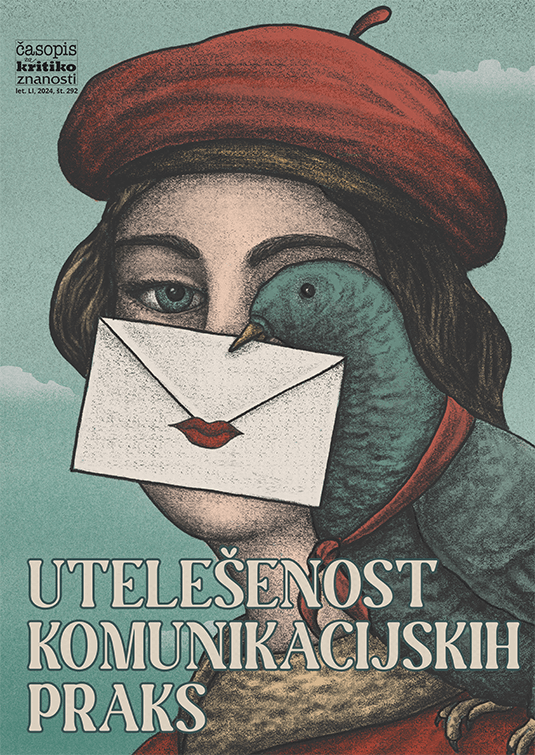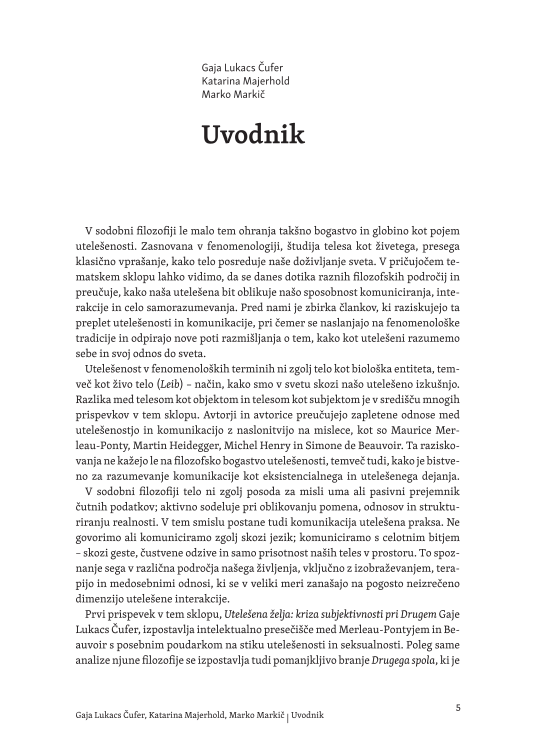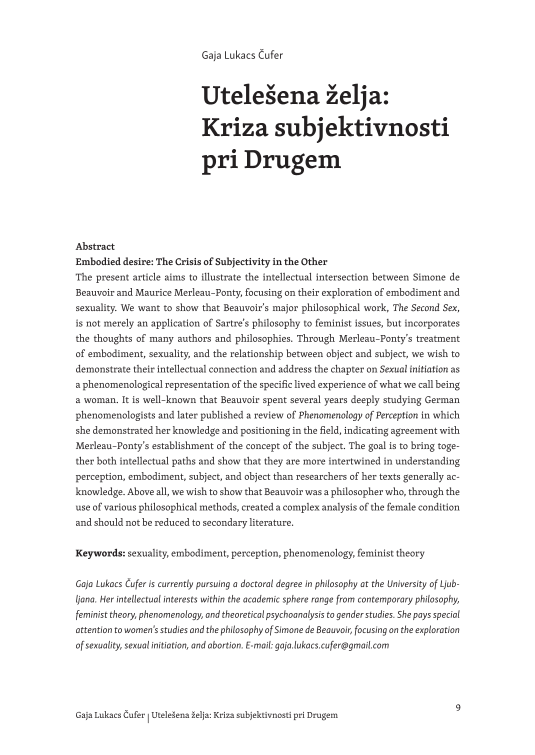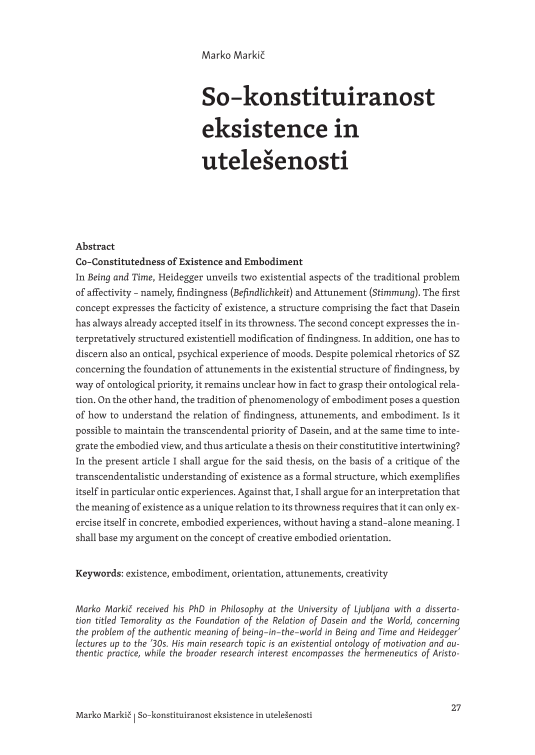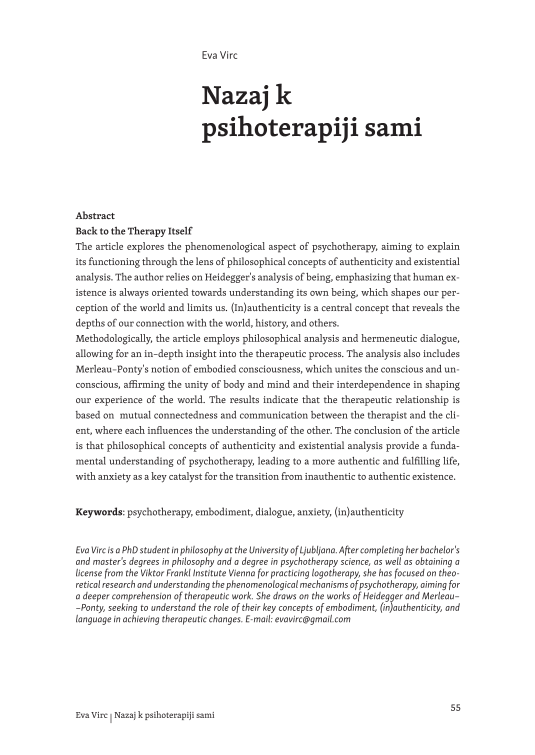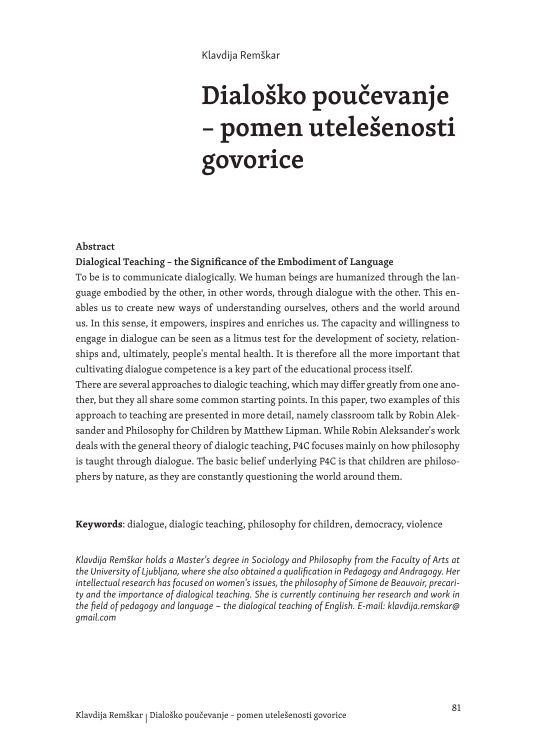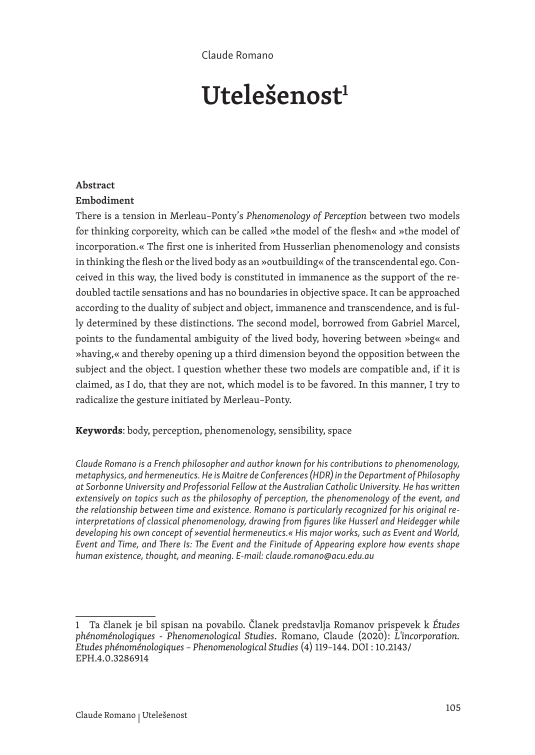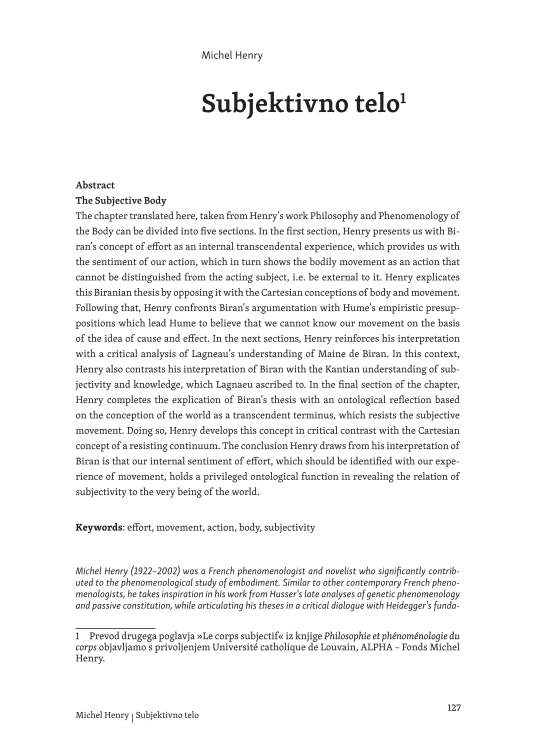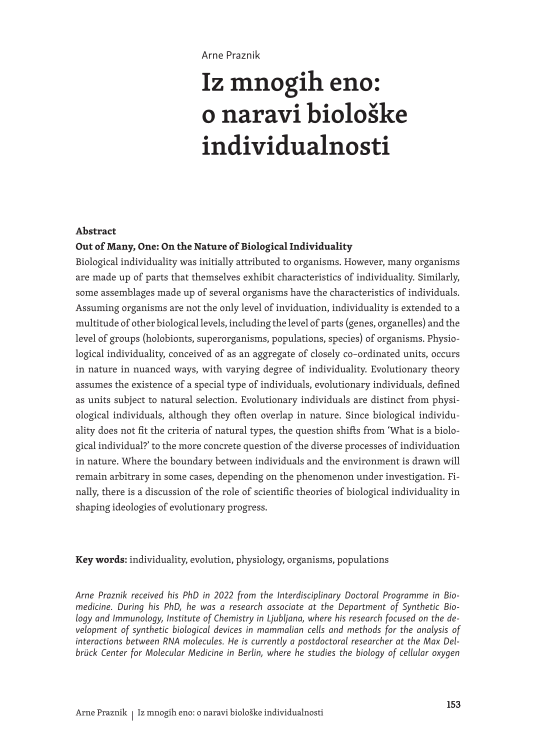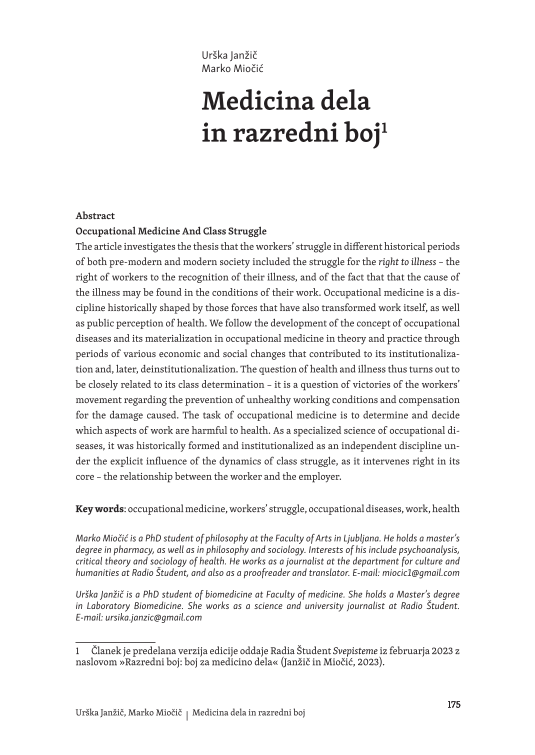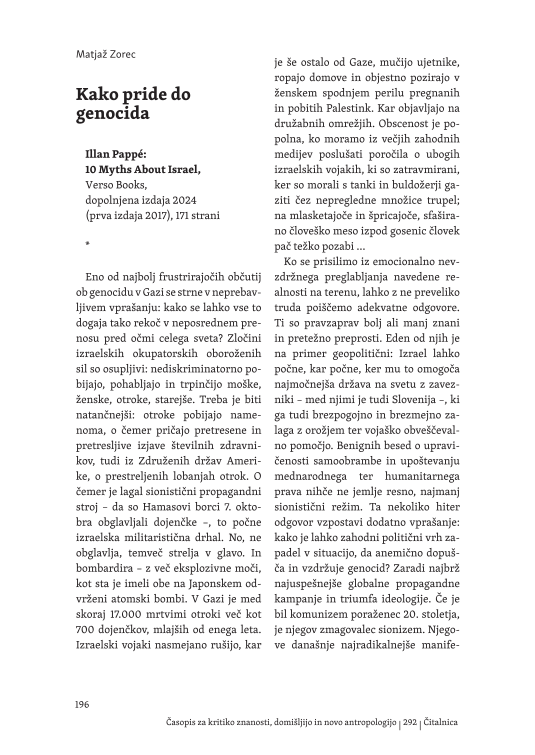V sodobni filozofiji le malo tem ohranja takšno bogastvo in globino kot pojem utelešenosti. Zasnovana v fenomenologiji, študija telesa kot živetega, presega klasično vprašanje, kako telo posreduje naše doživljanje sveta. V pričujočem tematskem sklopu lahko vidimo, da se danes dotika raznih filozofskih področij in preučuje, kako naša utelešena bit oblikuje našo sposobnost komuniciranja, interakcije in celo samorazumevanja. Pred nami je zbirka člankov, ki raziskujejo ta preplet utelešenosti in komunikacije, pri čemer se naslanjajo na fenomenološke tradicije in odpirajo nove poti razmišljanja o tem, kako kot utelešeni razumemo sebe in svoj odnos do sveta.
Utelešenost v fenomenoloških terminih ni zgolj telo kot biološka entiteta, temveč kot živo telo (Leib) – način, kako smo v svetu skozi našo utelešeno izkušnjo. Razlika med telesom kot objektom in telesom kot subjektom je v središču mnogih prispevkov v tem sklopu. Avtorji in avtorice preučujejo zapletene odnose med utelešenostjo in komunikacijo z naslonitvijo na mislece, kot so Maurice Merleau-Ponty, Martin Heidegger, Michel Henry in Simone de Beauvoir. Ta raziskovanja ne kažejo le na filozofsko bogastvo utelešenosti, temveč tudi, kako je bistveno za razumevanje komunikacije kot eksistencialnega in utelešenega dejanja.
The present article aims to illustrate the intellectual intersection between Simone de Beauvoir and Maurice Merleau–Ponty, focusing on their exploration of embodiment and sexuality. We want to show that Beauvoir’s major philosophical work, The Second Sex, is not merely an application of Sartre’s philosophy to feminist issues, but incorporates the thoughts of many authors and philosophies. Through Merleau–Ponty’s treatment of embodiment, sexuality, and the relationship between object and subject, we wish to demonstrate their intellectual connection and address the chapter on Sexual initiation as a phenomenological representation of the specific lived experience of what we call being a woman. It is well–known that Beauvoir spent several years deeply studying German phenomenologists and later published a review of Phenomenology of Perception in which she demonstrated her knowledge and positioning in the field, indicating agreement with Merleau–Ponty’s establishment of the concept of the subject. The goal is to bring toge-ther both intellectual paths and show that they are more intertwined in understanding perception, embodiment, subject, and object than researchers of her texts generally acknowledge. Above all, we wish to show that Beauvoir was a philosopher who, through the use of various philosophical methods, created a complex analysis of the female condition and should not be reduced to secondary literature.
In Being and Time, Heidegger unveils two existential aspects of the traditional problem of affectivity – namely, findingness (Befindlichkeit) and Attunement (Stimmung). The first concept expresses the facticity of existence, a structure comprising the fact that Dasein has always already accepted itself in its throwness. The second concept expresses the interpretatively structured existentiell modification of findingness. In addition, one has to discern also an ontical, psychical experience of moods. Despite polemical rhetorics of SZ concerning the foundation of attunements in the existential structure of findingness, by way of ontological priority, it remains unclear how in fact to grasp their ontological relation. On the other hand, the tradition of phenomenology of embodiment poses a question of how to understand the relation of findingness, attunements, and embodiment. Is it possible to maintain the transcendental priority of Dasein, and at the same time to integrate the embodied view, and thus articulate a thesis on their constitutitive intertwining? In the present article I shall argue for the said thesis, on the basis of a critique of the transcendentalistic understanding of existence as a formal structure, which exemplifies itself in particular ontic experiences. Against that, I shall argue for an interpretation that the meaning of existence as a unique relation to its throwness requires that it can only exercise itself in concrete, embodied experiences, without having a stand–alone meaning. I shall base my argument on the concept of creative embodied orientation.
The article explores the phenomenological aspect of psychotherapy, aiming to explain its functioning through the lens of philosophical concepts of authenticity and existential analysis. The author relies on Heidegger's analysis of being, emphasizing that human existence is always oriented towards understanding its own being, which shapes our perception of the world and limits us. (In)authenticity is a central concept that reveals the depths of our connection with the world, history, and others.
Methodologically, the article employs philosophical analysis and hermeneutic dialogue, allowing for an in–depth insight into the therapeutic process. The analysis also includes Merleau–Ponty's notion of embodied consciousness, which unites the conscious and unconscious, affirming the unity of body and mind and their interdependence in shaping our experience of the world. The results indicate that the therapeutic relationship is based on mutual connectedness and communication between the therapist and the client, where each influences the understanding of the other. The conclusion of the article is that philosophical concepts of authenticity and existential analysis provide a fundamental understanding of psychotherapy, leading to a more authentic and fulfilling life, with anxiety as a key catalyst for the transition from inauthentic to authentic existence.
To be is to communicate dialogically. We human beings are humanized through the language embodied by the other, in other words, through dialogue with the other. This enables us to create new ways of understanding ourselves, others and the world around us. In this sense, it empowers, inspires and enriches us. The capacity and willingness to engage in dialogue can be seen as a litmus test for the development of society, relationships and, ultimately, people's mental health. It is therefore all the more important that cultivating dialogue competence is a key part of the educational process itself.
There are several approaches to dialogic teaching, which may differ greatly from one another, but they all share some common starting points. In this paper, two examples of this approach to teaching are presented in more detail, namely classroom talk by Robin Aleksander and Philosophy for Children by Matthew Lipman. While Robin Aleksander's work deals with the general theory of dialogic teaching, P4C focuses mainly on how philosophy is taught through dialogue. The basic belief underlying P4C is that children are philosophers by nature, as they are constantly questioning the world around them.
There is a tension in Merleau–Ponty’s Phenomenology of Perception between two models for thinking corporeity, which can be called »the model of the flesh« and »the model of incorporation.« The first one is inherited from Husserlian phenomenology and consists in thinking the flesh or the lived body as an »outbuilding« of the transcendental ego. Conceived in this way, the lived body is constituted in immanence as the support of the redoubled tactile sensations and has no boundaries in objective space. It can be approached according to the duality of subject and object, immanence and transcendence, and is fully determined by these distinctions. The second model, borrowed from Gabriel Marcel, points to the fundamental ambiguity of the lived body, hovering between »being« and »having,« and thereby opening up a third dimension beyond the opposition between the subject and the object. I question whether these two models are compatible and, if it is claimed, as I do, that they are not, which model is to be favored. In this manner, I try to radicalize the gesture initiated by Merleau–Ponty.
The chapter translated here, taken from Henry's work Philosophy and Phenomenology of the Body can be divided into five sections. In the first section, Henry presents us with Biran’s concept of effort as an internal transcendental experience, which provides us with the sentiment of our action, which in turn shows the bodily movement as an action that cannot be distinguished from the acting subject, i.e. be external to it. Henry explicates this Biranian thesis by opposing it with the Cartesian conceptions of body and movement. Following that, Henry confronts Biran’s argumentation with Hume’s empiristic presuppositions which lead Hume to believe that we cannot know our movement on the basis of the idea of cause and effect. In the next sections, Henry reinforces his interpretation with a critical analysis of Lagneau’s understanding of Maine de Biran. In this context, Henry also contrasts his interpretation of Biran with the Kantian understanding of subjectivity and knowledge, which Lagnaeu ascribed to. In the final section of the chapter, Henry completes the explication of Biran’s thesis with an ontological reflection based on the conception of the world as a transcendent terminus, which resists the subjective movement. Doing so, Henry develops this concept in critical contrast with the Cartesian concept of a resisting continuum. The conclusion Henry draws from his interpretation of Biran is that our internal sentiment of effort, which should be identified with our experience of movement, holds a privileged ontological function in revealing the relation of subjectivity to the very being of the world.
Biological individuality was initially attributed to organisms. However, many organisms are made up of parts that themselves exhibit characteristics of individuality. Similarly, some assemblages made up of several organisms have the characteristics of individuals. Assuming organisms are not the only level of inviduation, individuality is extended to a multitude of other biological levels, including the level of parts (genes, organelles) and the level of groups (holobionts, superorganisms, populations, species) of organisms. Physiological individuality, conceived of as an aggregate of closely co–ordinated units, occurs in nature in nuanced ways, with varying degree of individuality. Evolutionary theory assumes the existence of a special type of individuals, evolutionary individuals, defined as units subject to natural selection. Evolutionary individuals are distinct from physiological individuals, although they often overlap in nature. Since biological individuality does not fit the criteria of natural types, the question shifts from ‘What is a biological individual?’ to the more concrete question of the diverse processes of individuation in nature. Where the boundary between individuals and the environment is drawn will remain arbitrary in some cases, depending on the phenomenon under investigation. Finally, there is a discussion of the role of scientific theories of biological individuality in shaping ideologies of evolutionary progress.
The article investigates the thesis that the workers’ struggle in different historical periods of both pre-modern and modern society included the struggle for the right to illness – the right of workers to the recognition of their illness, and of the fact that that the cause of the illness may be found in the conditions of their work. Occupational medicine is a discipline historically shaped by those forces that have also transformed work itself, as well as public perception of health. We follow the development of the concept of occupational diseases and its materialization in occupational medicine in theory and practice through periods of various economic and social changes that contributed to its institutionalization and, later, deinstitutionalization. The question of health and illness thus turns out to be closely related to its class determination – it is a question of victories of the workers’ movement regarding the prevention of unhealthy working conditions and compensation for the damage caused. The task of occupational medicine is to determine and decide which aspects of work are harmful to health. As a specialized science of occupational diseases, it was historically formed and institutionalized as an independent discipline under the explicit influence of the dynamics of class struggle, as it intervenes right in its core – the relationship between the worker and the employer.
Illan Pappé: 10 Myths About Israel, Verso Books, dopolnjena izdaja 2024 (prva izdaja 2017), 171 strani.
Eno od najbolj frustrirajočih občutij ob genocidu v Gazi se strne v neprebavljivem vprašanju: kako se lahko vse to dogaja tako rekoč v neposrednem prenosu pred očmi celega sveta? Zločini izraelskih okupatorskih oboroženih sil so osupljivi: nediskriminatorno pobijajo, pohabljajo in trpinčijo moške, ženske, otroke, starejše. Treba je biti natančnejši: otroke pobijajo namenoma, o čemer pričajo pretresene in pretresljive izjave številnih zdravnikov, tudi iz Združenih držav Amerike, o prestreljenih lobanjah otrok. O čemer je lagal sionistični propagandni stroj – da so Hamasovi borci 7. oktobra obglavljali dojenčke –, to počne izraelska militaristična drhal. No, ne obglavlja, temveč strelja v glavo. In bombardira – z več eksplozivne moči, kot sta je imeli obe na Japonskem odvrženi atomski bombi. V Gazi je med skoraj 17.000 mrtvimi otroki več kot 700 dojenčkov, mlajših od enega leta. Izraelski vojaki nasmejano rušijo, kar je še ostalo od Gaze, mučijo ujetnike, ropajo domove in objestno pozirajo v ženskem spodnjem perilu pregnanih in pobitih Palestink. Kar objavljajo na družabnih omrežjih. Obscenost je popolna, ko moramo iz večjih zahodnih medijev poslušati poročila o ubogih izraelskih vojakih, ki so zatravmirani, ker so morali s tanki in buldožerji gaziti čez nepregledne množice trupel; na mlasketajoče in špricajoče, sfaširano človeško meso izpod gosenic človek pač težko pozabi …



